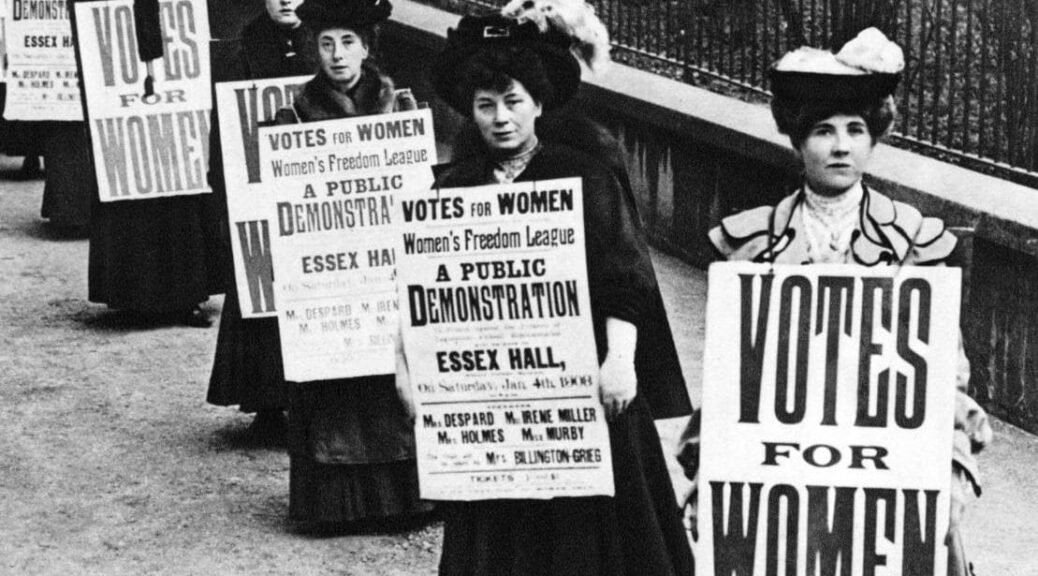The WOMEN’S SUFFRAGE MOVEMENT was a decades-long fight to win the right to vote for women in the United States. It took activists and reformers nearly 100 years to win that right, and the campaign was not easy: Disagreements over strategy threatened to cripple the movement more than once. But on August 18, 1920, the 19th Amendment to the Constitution was finally ratified, enfranchising all American women and declaring for the first time that they, like men, deserve all the rights and responsibilities of citizenship.
The campaign for women’s suffrage began in earnest in the decades before the Civil War. During the 1820s and 30s, most states had extended the franchise to all white men, regardless of how much money or property they had.
At the same time, all sorts of reform groups were proliferating across the United States— temperance leagues, religious movements, moral-reform societies, anti-slavery organizations—and in many of these, women played a prominent role.
Meanwhile, many American women were beginning to chafe against what historians have called the “Cult of True Womanhood”: that is, the idea that the only “true” woman was a pious, submissive wife and mother concerned exclusively with home and family.
Put together, all of these contributed to a new way of thinking about what it meant to be a woman and a citizen of the United States.
In 1848, a group of abolitionist activists—mostly women, but some men—gathered in Seneca Falls, New York to discuss the problem of women’s rights. They were invited there by the reformers Elizabeth Cady Stanton and Lucretia Mott.
Most of the delegates to the Seneca Falls Convention agreed: American women were autonomous individuals who deserved their own political identities.
“We hold these truths to be self-evident,” proclaimed the Declaration of Sentiments that the delegates produced, “that all men and women are created equal, that they are endowed by their creator with certain inalienable rights, that among these are life, liberty, and the pursuit of happiness.” What this meant, among other things, was that they believed women should have the right to vote.
During the 1850s, the women’s rights movement gathered steam, but lost momentum when the Cicil War began. Almost immediately after the war ended, the 14th Amendment and the 15th Amendment to the Constitution raised familiar questions of suffrage and citizenship.
The 14th Amendment, ratified in 1868, extends the Constitution’s protection to all citizens—and defines “citizens” as “male”; the 15th, ratified in 1870, guarantees Black men the right to vote.
Some women’s suffrage advocates believed that this was their chance to push lawmakers for truly universal suffrage. As a result, they refused to support the 15th Amendment and even allied with racist Southerners who argued that white women’s votes could be used to neutralize those cast by African Americans.
Starting in 1910, some states in the West began to extend the vote to women for the first time in almost 20 years. Idaho and Utah had given women the right to vote at the end of the 19th century. Still, southern and eastern states resisted. In 1916, NAWSA president Carrie Chapman Catt unveiled what she called a “Winning Plan” to get the vote at last: a blitz campaign that mobilized state and local suffrage organizations all over the country, with special focus on those recalcitrant regions.
Meanwhile, a splinter group called the National Woman’s Party founded by Alice Paul focused on more radical, militant tactics—hunger strikes and White House pickets, for instance—aimed at winning dramatic publicity for their cause.
World War I slowed the suffragists’ campaign but helped them advance their argument nonetheless: Women’s work on behalf of the war effort, activists pointed out, proved that they were just as patriotic and deserving of citizenship as men.
It fell to Tennessee to tip the scale for woman suffrage.
The outlook for ratification by the requisite number of states appeared bleak, given the outcomes in other Southern states and given the position of Tennessee’s state legislators in their 48-48 tie. The state’s decision came down to 23-year-old Representative Harry T. Burn, a Republican from McMinn County, to cast the deciding vote. Although Burn opposed the amendment, his mother convinced him to approve it. Mrs. Burn reportedly wrote to her son: “Don’t forget to be a good boy and help Mrs. Catt put the ‘rat’ in ratification.” With Burn’s vote, the 19th Amendment was fully ratified.
Finally, on August 18, 1920, the 19th Amendment to the Constitution was ratified. And on November 2 of that year, more than 8 million women across the United States voted in elections for the first time..
